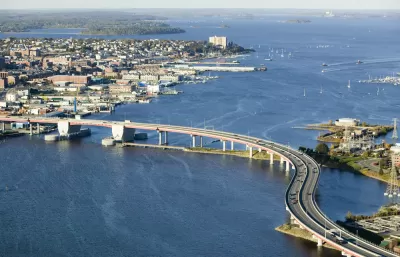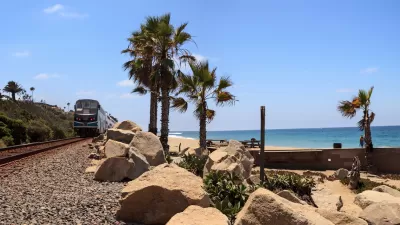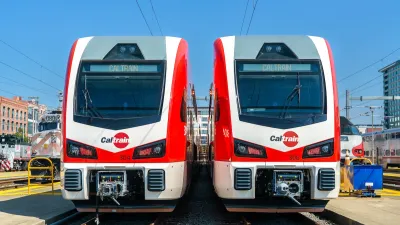A more concerted effort could bring together the state's recent plans and federal infrastructure investment to link the region and reduce greenhouse gas emissions.

Tony Donovan, writing in the Press Herald, argues that Maine leaders should take advantage of recent infrastructure investments and newly available federal funding to make a major push for a more well-connected rail system in the state.
"In 2020 the Governor’s Climate Council report found that the transportation sector is responsible for 54 percent of Maine’s total greenhouse-gas emissions, and that the Climate Council goal is to reduce emissions by 80 percent. The state now has in hand the Lewiston/Auburn Passenger Rail Service Plan, which positions Maine to address these needs head on," writes Donovan. The state's plan promises to move up to 600,000 commuters daily on hybrid-electric trains and bring a long-awaited connection to Montreal.
The holdup in completing these projects, according to Donovan, has been cost. "To succeed with innovative projects to meet much-needed goals, we cannot shy away from the costs. The costs of the status quo are much greater." With signs that the new administration will fund substantial infrastructure investments and private investors looking to train station sites as ripe for development, Donovan believe that Maine, a state with "the experience of creating and operating one of the most successful passenger train operations in the country," is uniquely positioned to develop a modern, comprehensive train system that will take vehicles off the road and provide seamless regional links.
FULL STORY: It is the perfect time for putting Maine on the move

Study: Maui’s Plan to Convert Vacation Rentals to Long-Term Housing Could Cause Nearly $1 Billion Economic Loss
The plan would reduce visitor accommodation by 25,% resulting in 1,900 jobs lost.

North Texas Transit Leaders Tout Benefits of TOD for Growing Region
At a summit focused on transit-oriented development, policymakers discussed how North Texas’ expanded light rail system can serve as a tool for economic growth.

Why Should We Subsidize Public Transportation?
Many public transit agencies face financial stress due to rising costs, declining fare revenue, and declining subsidies. Transit advocates must provide a strong business case for increasing public transit funding.

How to Make US Trains Faster
Changes to boarding platforms and a switch to electric trains could improve U.S. passenger rail service without the added cost of high-speed rail.

Columbia’s Revitalized ‘Loop’ Is a Hub for Local Entrepreneurs
A focus on small businesses is helping a commercial corridor in Columbia, Missouri thrive.

Invasive Insect Threatens Minnesota’s Ash Forests
The Emerald Ash Borer is a rapidly spreading invasive pest threatening Minnesota’s ash trees, and homeowners are encouraged to plant diverse replacement species, avoid moving ash firewood, and monitor for signs of infestation.
Urban Design for Planners 1: Software Tools
This six-course series explores essential urban design concepts using open source software and equips planners with the tools they need to participate fully in the urban design process.
Planning for Universal Design
Learn the tools for implementing Universal Design in planning regulations.
Ascent Environmental
Borough of Carlisle
Institute for Housing and Urban Development Studies (IHS)
City of Grandview
Harvard GSD Executive Education
Toledo-Lucas County Plan Commissions
Salt Lake City
NYU Wagner Graduate School of Public Service





























